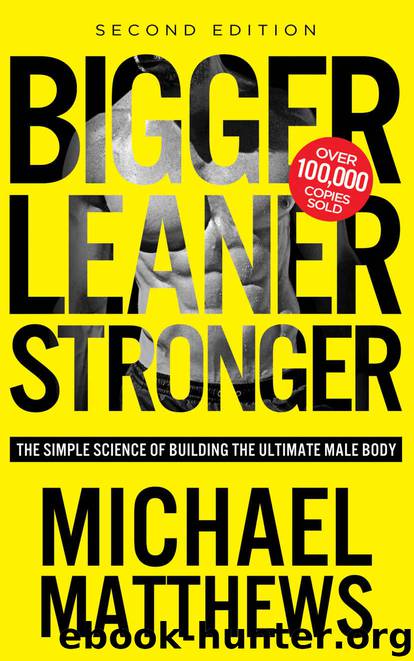Bigger Leaner Stronger: The Simple Science of Building the Ultimate Male Body (Bodybuilding Books, Building Muscle, Weightlifting, Fitness Training, Weight Training, Lose Fat Book 1) by Michael Matthews

Author:Michael Matthews [Matthews, Michael]
Language: eng
Format: azw3, epub
Publisher: Waterbury Publications, Inc.
Published: 2014-01-05T05:00:00+00:00
THE SQUAT
Many guys think leg training consists of loading up the leg press with every plate in the gym and using tourniquet-tight knee wraps and a weight belt cinched to its tightest notch, only to wiggle into the sled, grind out a few excruciating quarter reps, and celebrate with an ear-splitting yell and high-fives with his buddies.
Good news: that’s not going to be you. You’re going to be the guy in the corner with the squat rack—you know, the loneliest place in the gym—quietly going about your business with deep, heavy squats. No wraps, no belts, no swagger—just a bar bending across your back, loaded with a “measly” few hundred pounds (yes, you’ll get there) and a puddle of sweat on the ground.
Who’s going to be the winner in the end? Who’s going to consistently get bigger and stronger, and who’s the least likely to get hurt? You, of course.
While many guys will do anything for leg training before putting the barbell on their backs, they’re missing out on what many of the top strength coaches in the world consider the absolute toughest and most rewarding exercise we can do.
To nobody’s surprise, squatting strengthens every muscle in your legs, which doesn’t just increase the amount of weight you can lift—it also helps you run faster and jump higher, and it improves flexibility, mobility, and agility.1 And as if those aren’t reasons enough to squat regularly, it’s also an incredibly effective core workout.2
Laziness aside, why do so many people avoid squatting? Well, more often than not, they’ve fallen victim to the myths that the squat is bad for your back and knees—a lie that has been perpetuated for about five decades now.
It all started with work done in the 1960s, when research concluded that a deep squat stretched the knee ligaments too far, increasing the risk of injury. These findings spread like wildfire through the fitness world, and some U.S. military services even cut squatting movements out of their training programs.
It was noted at the time that the studies had serious flaws, including the choice of subjects and researcher bias, but that wasn’t enough to stop the uprising against the squat. For instance, one of the studies was done with parachute jumpers, whose knees had been repeatedly pounded with violent impacts and twisted all over the place in parachute lines.
Well, much more research has been done since then, and a much different picture has emerged.
A rigorous study conducted by scientists at Duke University involved the analysis of more than two decades of published literature to determine, in great detail, the biomechanics of the squat exercise and the stresses it places on the ankles, knees, hip joint, and spine.3
Highlights from the paper, and many studies reviewed within, set the record straight on how the squat affects our bodies and teach us a lot about proper squat form:
• The hamstrings counteract the pull on the shinbone, which neutralizes the shearing force placed on the knee and alleviates stress on the ACL.
• Even in extreme cases, such as powerlifters lifting 2.
Download
Bigger Leaner Stronger: The Simple Science of Building the Ultimate Male Body (Bodybuilding Books, Building Muscle, Weightlifting, Fitness Training, Weight Training, Lose Fat Book 1) by Michael Matthews.epub
This site does not store any files on its server. We only index and link to content provided by other sites. Please contact the content providers to delete copyright contents if any and email us, we'll remove relevant links or contents immediately.
Tools of Titans by Timothy Ferriss(7815)
Bodyweight Strength Training by Jay Cardiello(7676)
Born to Run: by Christopher McDougall(6895)
Inner Engineering: A Yogi's Guide to Joy by Sadhguru(6441)
Asking the Right Questions: A Guide to Critical Thinking by M. Neil Browne & Stuart M. Keeley(5357)
The Fat Loss Plan by Joe Wicks(4622)
Bodyweight Strength Training Anatomy by Bret Contreras(4472)
Yoga Anatomy by Kaminoff Leslie(4103)
Science and Development of Muscle Hypertrophy by Brad Schoenfeld(3971)
Dynamic Alignment Through Imagery by Eric Franklin(3920)
ACSM's Complete Guide to Fitness & Health by ACSM(3824)
The Four-Pack Revolution by Chael Sonnen & Ryan Parsons(3795)
Exercise Technique Manual for Resistance Training by National Strength & Conditioning Association(3788)
Bodyweight Strength Training: 12 Weeks to Build Muscle and Burn Fat by Jay Cardiello(3781)
Yoga Anatomy by Leslie Kaminoff & Amy Matthews(3740)
The Ultimate Bodybuilding Cookbook by Kendall Lou Schmidt(3708)
Yoga Therapy by Mark Stephens(3574)
Nutrition for Sport, Exercise, and Health by Spano Marie & Kruskall Laura & Thomas D. Travis(3556)
Nutrition for Sport, Exercise, and Health by Marie Spano & Laura Kruskall & D. Travis Thomas(3548)
